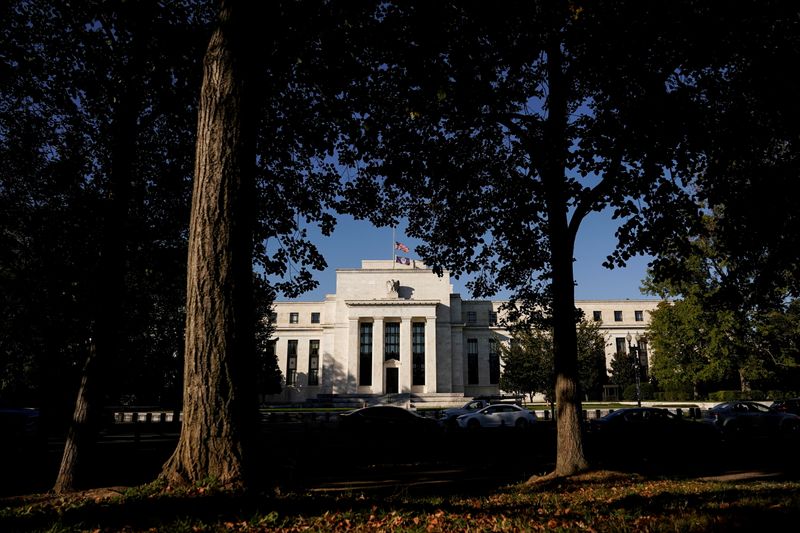(Bloomberg) -- Federal Reserve officials this week will quicken their wind-down of bond purchases and signal interest-rate liftoff in 2022, economists surveyed by Bloomberg said, heralding a historic policy pivot to counter the fastest inflation since the 1980s.
More than half predict the Fed’s quarterly forecasts, released after the conclusion of its two-day meeting Wednesday, will show the median of 18 officials projecting two rate hikes next year from current levels near zero.
That’s a change from the September predictions, when policy makers were evenly split between liftoff in 2022 or 2023. The survey of 49 economists was conducted Dec. 3-8.
“It’s going to be the biggest hawkish shift in the history of the dot plot,” said Laura Rosner-Warburton, senior economist at Macropolicy Perspectives, referring to Fed rate forecasts which have been published since 2012.
Chair Jerome Powell told lawmakers on Nov. 30 it would be appropriate to consider speeding up the taper to end a few months earlier than the originally planned conclusion in mid-2022.
Tapering Outlook
“The tapering process has become a straightjacket, preventing the Fed from responding to the higher than expected level and persistence of inflation,” said Philip Marey, senior U.S. strategist at Rabobank, in a survey response. “Therefore, they are likely to double the pace of tapering to create the option to hike as early as in March.”
Bets in interest rate futures markets show around 66 basis points of tightening priced in by the end of next year.
More than half of the economists expect the policy-setting Federal Open Market Committee to double the pace of tapering to $30 billion a month, starting in January and wrapping up in March.
What Bloomberg Economics Says
“The committee is expected to step up the pace of tapering its bond purchases; Bloomberg Economics expects it to double the pace, bringing net purchases to a halt in March. The key issue will be the rationale the committee offers for making the adjustment. A logical step would be to ground the move in recent news about the labor market and inflation.”
-- David Wilcox, director of U.S. economic research
Policy makers are expected to pencil in two rate hikes in 2022, forecast three moves in 2023 and two more in 2024, with rates reaching 1.9% that year. That represents a somewhat steeper rate path than the FOMC projected in September. The trajectory matches predictions by economists, who see rates hitting 2% in 2024.
Powell Pivot
Powell’s pivot toward a more hawkish outlook on tapering has been brought about by surging inflation. Since the Fed’s Nov. 2-3 meeting, data has shown consumer prices rising 6.2% in October and 6.8% in November -- the fastest rate since 1982.
Nearly half of the economists polled said the surge, concern about inflation at the White House and Powell’s renomination as Fed chair have all contributed to the adjustment in stance.
“The forecast will show an increase in inflation, drop in unemployment and massive shift in rate hikes to 2022,” said Diane Swonk, chief economist at Grant Thornton LLP. “This will signal the first time since the 1980s that the Fed actually admits it is chasing instead instead of preempting what at times was a non-existent inflation. That is a major break from the past.”
The FOMC is likely to see inflation persisting, raising its forecasts for 2022 overall inflation to 2.5%, according to the survey. Policy makers are also predicted to show unemployment falling to 3.7% at the end of 2022, which would be below their long-term forecasts of 4%.
Economists expect the Fed to retain language in its policy statement that it does not plan to raise interest rates until the U.S. reaches “maximum employment” and inflation reaches 2% and is on track to exceed 2% for some time.
Almost all the economists, however, expect the FOMC to modify or drop its phrase that inflation largely reflects factors “expected to be transitory,” after Powell told Congress that it’s time to retire the word “transitory.”
Omicron Impact
Most Fed officials have said it’s too early to determine the economic effect of the new omicron variant of Covid-19. Roughly two-thirds of the economists say the FOMC is likely to see the strain reducing U.S. growth modestly but having the potential to boost prices.
“There are significant uncertainties presented by omicron, which could weigh on growth and job creation while having a more mixed influence on inflation,” said James Knightley, chief international economist at ING Financial Markets LLC. While he expects two 2022 rate hikes, “if scientific evidence suggests we are not entering a darker period for the pandemic we would imagine three hikes is far more likely.”
The economists see the risks to monetary policy, in terms of inflation, as tilted to the upside, while risks to growth are tilted to the downside or roughly balanced.
Vice Chair For Supervision
President Joe Biden has renominated Powell and named Lael Brainard to be vice chairman, but still has three other slots to fill on the Fed board including a new vice chair for supervision, responsible for setting the agenda for regulations on Wall Street’s big banks.
Economists were split on who will get the nod, with 34% expecting Richard Cordray, former director of the Consumer Financial Protection Bureau, followed by former Fed Governor Sarah Bloom Raskin with 25%, and Raphael Bostic, Atlanta Fed president, with 19%.
“The White House wants Cordray,” said Chris Low, chief economist at FHN Financial. “If they do not think they can get the necessary votes, President Biden will nominate Bloom Raskin.” Bostic lacks supervisory experience but “could get the nod for one of the empty board seats.”
©2021 Bloomberg L.P.
